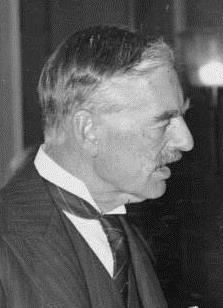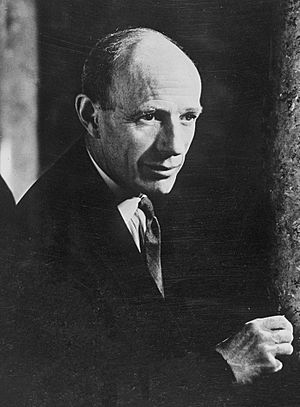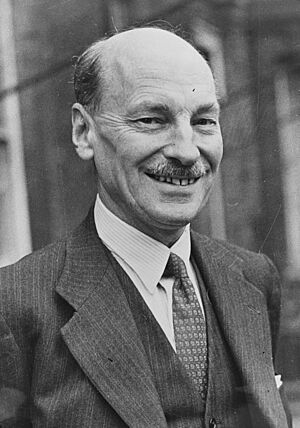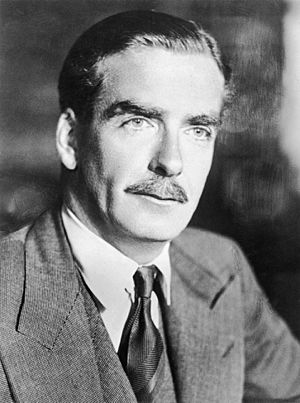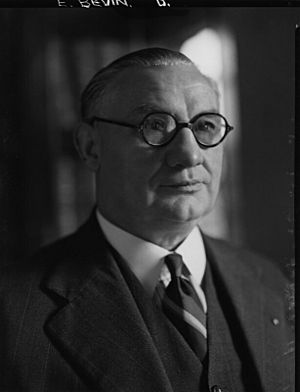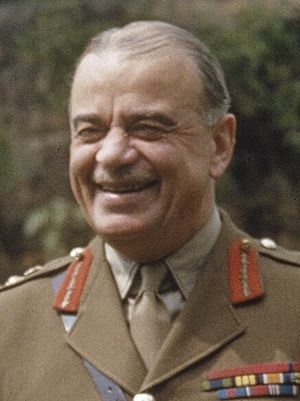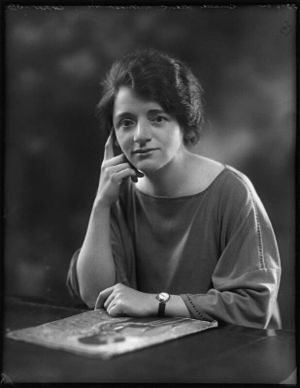Churchill war ministry facts for kids
Quick facts for kids Churchill war ministry |
|
|---|---|
| 1940–1945 | |
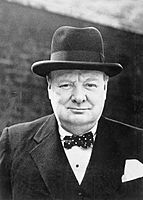
Winston Churchill on 2 August 1944
|
|
| Date formed | 10 May 1940 |
| Date dissolved | 23 May 1945 |
| People and organisations | |
| Monarch | George VI |
| Prime Minister | Winston Churchill |
| Deputy Prime Minister | Clement Attlee (1942–1945) |
| Total no. of members | 223 appointments |
| Member parties |
|
| Status in legislature | Supermajority (grand coalition)
604 / 615 (98%)
|
| History | |
| Legislature term(s) | 37th UK Parliament |
| Incoming formation | Norway Debate |
| Predecessor | Chamberlain war ministry |
| Successor | Churchill caretaker ministry |
The Churchill war ministry was the special government of the United Kingdom during most of World War II. It was a coalition government, meaning it was made up of different political parties working together. This government lasted from May 10, 1940, to May 23, 1945. It was led by Winston Churchill, who became Prime Minister of the United Kingdom after Neville Chamberlain resigned. King George VI asked Churchill to form this new government.
When it first started, Churchill created a small "war cabinet" with five important members. These included Chamberlain, Clement Attlee, Viscount Halifax, and Arthur Greenwood. As the war went on, more people joined this special cabinet. By late 1940, it had eight members, including Ernest Bevin, Anthony Eden, Lord Beaverbrook, and Kingsley Wood.
This special government ended in May 1945, after Germany was defeated. The Labour Party decided to leave the coalition to get ready for a new election. King George VI then asked Churchill, who was the leader of the Conservative Party, to form a new, mostly Conservative government. This was called the Churchill caretaker ministry. It ran the country until the general election on July 26, 1945.
Contents
Why a New Government Was Needed
Before Churchill, Stanley Baldwin was Prime Minister. In 1937, Neville Chamberlain took over. Chamberlain tried to avoid war by making agreements with leaders like Hitler. This was called "appeasement." But Hitler kept being aggressive. In 1939, Britain promised to support Poland if it was attacked. When Germany invaded Poland, Britain declared war on September 3, 1939. Churchill, who had been out of government for a while, became the head of the Navy.
However, many people were unhappy with Chamberlain's leadership, especially after Germany successfully invaded Norway in spring 1940. This led to a big discussion in the House of Commons called the Norway Debate. At the end of this debate, the Labour Party called for a vote to show they no longer trusted Chamberlain. Even though his government won, their majority was much smaller than usual. This showed that Chamberlain had lost a lot of support.
Forming a New Government: May 1940
Chamberlain Considers His Choices
On May 9, 1940, Chamberlain tried to form a new government that included all major parties. He met with Viscount Halifax and Churchill. Chamberlain said he would resign if it helped the Labour Party join. The Labour Party leaders, Clement Attlee and Arthur Greenwood, said they probably wouldn't work under Chamberlain. But they might work under another Conservative leader.
After the Labour leaders left, Chamberlain asked who he should suggest to King George VI as his replacement. Churchill later wrote that Chamberlain seemed to prefer Halifax. But Halifax said he couldn't lead the government effectively because he was in the House of Lords (the upper house of Parliament) and not the House of Commons (where most laws are made and debated). He felt that the Prime Minister needed to be in the Commons. Halifax also thought Churchill would be a better choice.
Churchill Becomes Prime Minister
On the morning of Friday, May 10, 1940, Germany invaded the Netherlands, Belgium, and Luxembourg. This made it clear that a strong, united government was urgently needed. Chamberlain realized he had to resign. He went to Buckingham Palace to tell the King. The King then asked Churchill to form a new government.
That evening, Churchill announced the change on the BBC. His first action was to meet with Attlee and Greenwood from the Labour Party. They talked late into the night and agreed on who would be in the new "war cabinet." Churchill promised that more than a third of the government jobs would go to Labour members, including some very important roles.
A National Government Takes Shape
On May 11, the Labour Party agreed to join Churchill's new "national government." This government was designed to unite the country to win the war. Clement Attlee, the Labour leader, became Lord Privy Seal and later Deputy Prime Minister. Arthur Greenwood, Labour's deputy leader, became a minister without a specific department.
One challenge for Churchill was that he wasn't the leader of the main Conservative Party. To get their support, he had to include Chamberlain in the war cabinet. Churchill also made himself Minister of Defence. This meant he would lead the special committee that planned the war. This committee was very important in 1940 and 1941.
Other key appointments included Anthony Eden as Secretary of State for War, A. V. Alexander (Labour) as head of the Navy, and Sir Archibald Sinclair (Liberal Party leader) as head of the Air Force. Important military leaders like Dudley Pound (Navy), Cyril Newall (Air Force), and Edmund Ironside (Army) also worked closely with the government.
Key civil servants like Sir Edward Bridges (Cabinet Secretary) and General Sir Hastings Ismay (Churchill's military adviser) were always present at war cabinet meetings. They helped make sure everything ran smoothly.
Churchill's First Speech as Prime Minister
By May 13, most of the main government jobs were filled. That day, Churchill gave his first speech as Prime Minister to the House of Commons. He said:
I beg to move, that this House welcomes the formation of a Government representing the united and inflexible resolve of the nation to prosecute the war with Germany to a victorious conclusion.
He explained that a small war cabinet had been formed to show the country's unity. He ended his speech with a very famous statement:
I have nothing to offer but blood, toil, tears and sweat.
He told the House that they faced a very difficult time, with "many, many long months of struggle and of suffering." He made it clear that their only goal was "victory, victory at all costs." He said that without victory, there would be no survival for Britain. He ended by asking everyone to "go forward together with our united strength."
The Labour Party confirmed they would support the government, showing a united front against Germany.
Completing the Government
By the end of his first week, Churchill had almost all his government members in place. Only two women were appointed to government roles: Florence Horsbrugh and Ellen Wilkinson.
War Cabinet Crisis in May 1940
As Germany quickly took over northern France and the Low Countries, the war became very dangerous for Britain. British troops were trapped at Dunkirk and needed to be rescued. During this time, a serious disagreement happened in the war cabinet. Some, like Halifax, wanted to ask Mussolini to help make a peace deal with Hitler. But Churchill wanted to keep fighting. Attlee and Greenwood supported Churchill. Even Chamberlain, after some thought, agreed with Churchill's decision to fight on.
Changes in the Government (1940-1945)
The war cabinet changed over time as the war progressed.
- August 1940: Lord Beaverbrook, who was in charge of aircraft production, joined the war cabinet.
- September 1940: Neville Chamberlain resigned due to illness and sadly passed away in November. Sir John Anderson took his place in the war cabinet. Kingsley Wood (in charge of money) and Ernest Bevin (in charge of labour) also joined the war cabinet.
- December 1940: Anthony Eden became the new Foreign Secretary, replacing Lord Halifax, who went to the United States as an ambassador. Eden also joined the war cabinet.
- June 1941: Lord Beaverbrook took on a new role in charge of supplies. Oliver Lyttelton joined the war cabinet as a special minister for the Middle East.
- February 1942: Clement Attlee became Deputy Prime Minister, taking charge of domestic affairs. Sir Stafford Cripps joined the war cabinet to help Churchill with his workload.
- November 1942: Herbert Morrison, the Home Secretary, joined the war cabinet.
- September 1943: After Sir Kingsley Wood's death, Sir John Anderson became the new Chancellor of the Exchequer (in charge of the country's money). Attlee also took on a new role as Lord President of the Council, while remaining Deputy Prime Minister.
- November 1943: Lord Woolton joined the war cabinet to plan for rebuilding Britain after the war.
- June 1944: D-Day happened, a major turning point in the war.
- November 1944: Lord Moyne, a minister for the Middle East, was sadly killed.
- April 1945: Hitler died.
- May 1945: VE Day (Victory in Europe Day) marked the end of the war in Europe. The war cabinet members at this time were Churchill, Attlee, Anderson, Bevin, Eden, Lyttelton, Morrison, and Woolton.
The End of the Ministry
In October 1944, Churchill suggested that Parliament, which had been elected in 1935, should continue for another year. He expected Germany to be defeated in spring 1945, but thought the war against Japan would last until 1946. He believed the end of the war in Europe should decide when the next election would be held.
After VE Day in May 1945, Clement Attlee met with Churchill to discuss the future of the coalition government. Attlee agreed with Churchill that the government should continue until Japan surrendered. However, other Labour Party leaders, especially Morrison and Bevin, wanted an election in October. On May 20, Attlee found that most of his party wanted an election sooner. So, he told Churchill that Labour had to leave the coalition.
On May 23, the Labour Party left the government to start their election campaign. Churchill resigned as Prime Minister. But the King asked him to form a new government, called the Churchill caretaker ministry, until the election in July. Churchill agreed, and this new, mostly Conservative government ran the country for two months. After the election, Attlee's Labour government took over.
Images for kids


